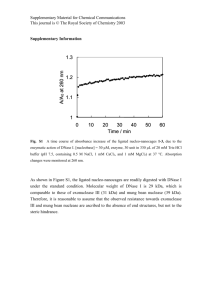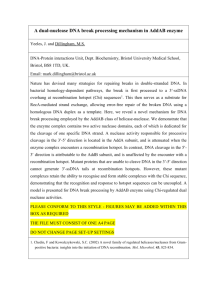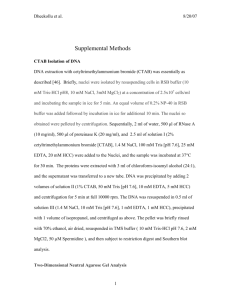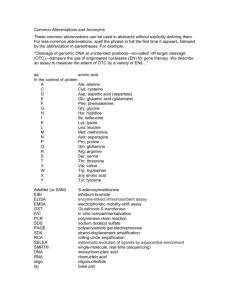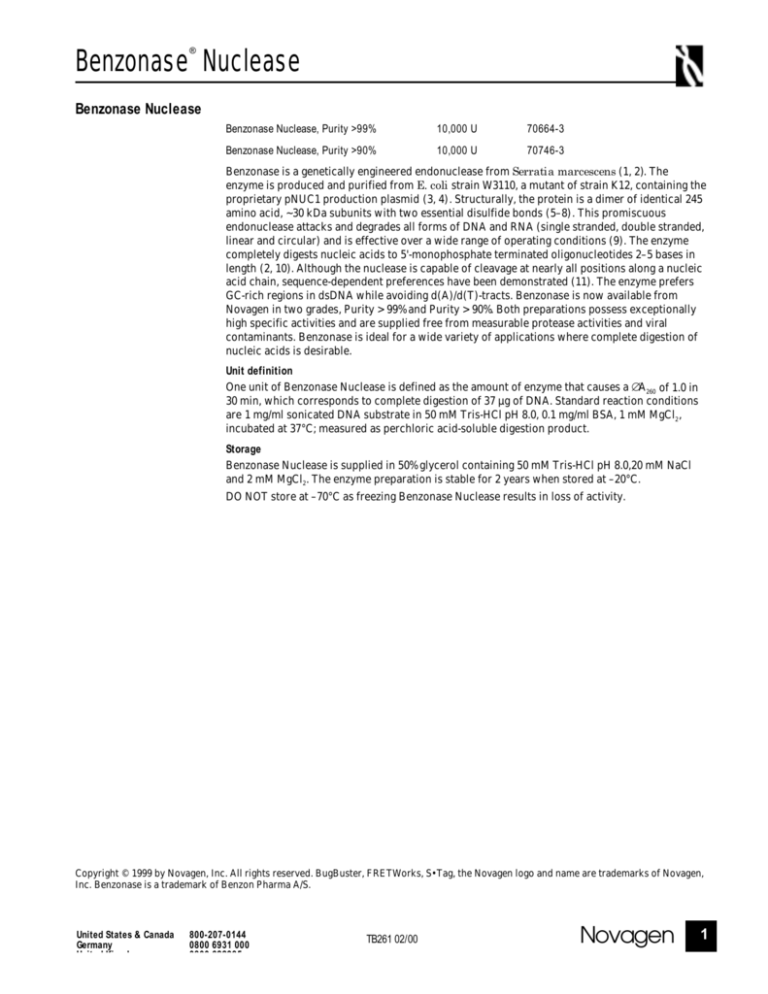
®
Benzonase Nuclease
Benzonase Nuclease
Benzonase Nuclease, Purity >99%
10,000 U
70664-3
Benzonase Nuclease, Purity >90%
10,000 U
70746-3
Benzonase is a genetically engineered endonuclease from Serratia marcescens (1, 2). The
enzyme is produced and purified from E. coli strain W3110, a mutant of strain K12, containing the
proprietary pNUC1 production plasmid (3, 4). Structurally, the protein is a dimer of identical 245
amino acid, ~30 kDa subunits with two essential disulfide bonds (5–8). This promiscuous
endonuclease attacks and degrades all forms of DNA and RNA (single stranded, double stranded,
linear and circular) and is effective over a wide range of operating conditions (9). The enzyme
completely digests nucleic acids to 5'-monophosphate terminated oligonucleotides 2–5 bases in
length (2, 10). Although the nuclease is capable of cleavage at nearly all positions along a nucleic
acid chain, sequence-dependent preferences have been demonstrated (11). The enzyme prefers
GC-rich regions in dsDNA while avoiding d(A)/d(T)-tracts. Benzonase is now available from
Novagen in two grades, Purity > 99% and Purity > 90%. Both preparations possess exceptionally
high specific activities and are supplied free from measurable protease activities and viral
contaminants. Benzonase is ideal for a wide variety of applications where complete digestion of
nucleic acids is desirable.
Unit definition
One unit of Benzonase Nuclease is defined as the amount of enzyme that causes a ∆A260 of 1.0 in
30 min, which corresponds to complete digestion of 37 µg of DNA. Standard reaction conditions
are 1 mg/ml sonicated DNA substrate in 50 mM Tris-HCl pH 8.0, 0.1 mg/ml BSA, 1 mM MgCl2 ,
incubated at 37°C; measured as perchloric acid-soluble digestion product.
Storage
Benzonase Nuclease is supplied in 50% glycerol containing 50 mM Tris-HCl pH 8.0,20 mM NaCl
and 2 mM MgCl2. The enzyme preparation is stable for 2 years when stored at –20°C.
DO NOT store at –70°C as freezing Benzonase Nuclease results in loss of activity.
Copyright © 1999 by Novagen, Inc. All rights reserved. BugBuster, FRETWorks, S•Tag, the Novagen logo and name are trademarks of Novagen,
Inc. Benzonase is a trademark of Benzon Pharma A/S.
United States & Canada
Germany
U it d Ki d
800-207-0144
0800 6931 000
0800 622935
TB261 02/00
Novagen
1
®
Benzonase Nuclease
Using Benzonase Nuclease
Applications
• Viscosity reduction in protein extracts
• Sample preparation for 2D gel electrophoresis
• Removal of nucleic acid contaminants from recombinant protein preparations
Notes
a) Benzonase Nuclease retains its activity under a wide range of conditions as follows.
Condition
Mg2+ concentration (see note d below)
pH
Temperature
Dithiothreitol
2-mercaptoethanol
Monovalent cation concentration (Na+, K +, etc.)
Optimal
1–2 mM
8.0–9.0
37°C
0–100 mM
0–100 mM
0–20 mM
Effective
1–10 mM
6.0–10.0
0–42°C
> 100 mM
> 100 mM
0–150 mM
b)
Benzonase is inhibited (approximately 50% reduction in relative activity) by monovalent
cation concentrations > 50 mM, phosphate concentrations > 20 mM, and by ammonium
sulfate concentrations > 25 mM.
c)
Benzonase can be diluted for ease of handling small quantities with 50 mM Tris-HCl pH 8, 20
mM NaCl, and 2 mM MgCl2. Diluted samples can be stored at 4°C for several days without
loss of activity.
d)
Although Benzonase requires Mg2+ for activation, it does not appear to require additional
Mg2+ under many conditions.
e)
Benzonase treatment is not generally recommended for purification of proteins that must be
nuclease free. However, depending on the processing methods, Benzonase may be removed
during purification. Residual nuclease activity can be checked by incubation of the purified
protein with RNA or DNA markers followed by gel analysis.
a)
Benzonase appears to have no effect on the FRETWorks™ S•Tag™ Assay.
Examples
The following examples illustrate the use of Benzonase Nuclease, and are intended as guidelines
only. Optimal conditions will vary from application to application, depending on buffer
compositions, sample properties and reaction conditions.
Viscosity reduction in E. coli lysates
7.5 g of E. coli W 3110 (wet weight) were resuspended in 15 ml of 10 mM Tris-HCl pH 9.0, 1 mM
EDTA. MgCl2 was added to a final concentration of 6 mM. 5 ml aliquots were taken from the
suspension, and Benzonase Nuclease Purity > 90% was added at increasing concentrations.
The aliquots were passed through a French press at 10,000 psi and immediately placed at 0°C.
Viscosity was judged at various time intervals by dripping from a pipet tip.
Benzonase Nuclease concentration
0.24 U/ml
2.40 U/ml
8.0 U/ml
24.0 U/ml
Incubation time to obtain “aqueous” drops
> 60 min
15 min
5 min
1.25 min
Use in conjunction with BugBuster™ Protein Extraction Reagent
Benzonase Nuclease is ideal for use in combination with BugBuster reagent for rapid, convenient
preparation of soluble protein extracts of E. coli. Whereas BugBuster alone causes efficient lysis,
2
Novagen
TB261 02/00
United States & Canada
Germany
United Kingdom
800-207-0144
0800 6931 000
0800 622935
®
Benzonase Nuclease
extracts can be viscous due to high molecular weight genomic DNA and other nucleic acids. The
addition of 25 U/ml Benzonase Nuclease to the BugBuster extraction mix greatly reduces the
viscosity of the extract during a 20 minute incubation at room temperature. No additives are
required; Benzonase remains fully active in 1X BugBuster reagent for weeks at 4°C (unpublished
results). Benzonase-treated extracts produce excellent flow rates on chromatography columns,
and purification runs can be performed in much less time vs. untreated extracts.
Removal of nucleic acids
A solution of herring sperm DNA was made in 50 mM Tris-HCl pH 8.0, 1 mM MgCl2, 0.1 mg/ml
BSA. Samples were treated with various concentrations of Benzonase Nuclease at 0°C, 23°C or
37°C. At increasing time intervals, 10 µl aliquots (initially containing 500 ng DNA) were removed
and applied to nitrocellulose membrane. The blot was probed with 32P-labeled herring sperm
DNA under low stringency hybridization and washing conditions to optimize detection of
repetitive sequences in the herring sperm DNA. DNA standards from 100 ng down to 10 pg
allowed semiquantitative evaluation of residual hybridizable DNA.
Residual hybridizable DNA (in ng) after increasing incubation time
Benzonase Nuclease concentration
90 U/ml
9 U/ml
0h
500 ng
500
4h
0.2
5
6h
0.02
2
22 h
none*
0.3
*not detectable after 30 h exposure
Residual hybridizable DNA (in ng) after increasing incubation time with 90 U/ml
Incubation temperature
37°C
23°C
0°C
0h
500 ng
500
500
4h
0.20
0.5
1
6h
0.02
0.100
0.500
22 h
none*
0.01
0.05
30 h
none*
none*
0.01
*not detectable after 30 h exposure
Residual hybridizable DNA (in ng) after increasing incubation time with 90 U/ml
Buffer
Tris buffer (23°C)
PBS buffer (23°C)
0h
500 ng
500
4h
0.5
5
6h
0.1
1
22 h
none*
0.50
30 h
none*
0.3
*not detectable after 30 h exposure
Related Products
Product
BugBuster™ Protein Extraction Reagent
BugBuster Plus Benzonase
Size
100 ml
500 ml
500 ml
plus 10,000 U
Cat. No.
70584-3
70584-4
70750-3
References
United States & Canada
Germany
U it d Ki d
1.
Eaves, G. N. and Jeffries, C. D. (1963) J. Bact. 85, 273–278
2.
Nestle, M. and Roberts, W. K. (1969) J. Biol. Chem. 244, 5219–5225
3.
Molin, S., Givskov, M. and Riise, E. (1992) , Benzon Pharma, A/S, Hvidovre, Denmark,
European Patent No. 0229866
4.
Molin, S., Givskov, M. and Riise, E. (1992) , Benzon Pharma, A/S, Hvidovre, Denmark, US
Patent No. 5,173,418
5.
Miller, M. D., Tanner, J., Alpaugh, M., Benedik, M. J. and Krause, K. L. (1994) Nat. Struct.
Biol. 1, 461–468
800-207-0144
0800 6931 000
0800 622935
TB261 02/00
Novagen
3
®
Benzonase Nuclease
4
Novagen
6.
Friedhoff, P., Gimadutdinow, O., Ruter, T., Wende, W., Urbanke, C., Thole, H. and Pingoud,
A. (1994) Protein Expr. Purif. 5, 37–43
7.
Ball, T. K., Suh, Y. and Benedik, M. J. (1992) Nucleic Acids Res. 20, 4971–4974
8.
Ball, T. K., Saurugger, P. N. and Benedik, M. J. (1987) Gene 57, 183–192
9.
Benzonase ® Brochure (1999) Code No. W 220911, Merck KGaA, Darmstadt, Germany
10.
Janning, P., Schrader, W. and Linscheid, M. (1994) Rapid Commun. Mass Spectrom. 8,
1035–1040
11.
Meiss, G., Friedhoff, P., Hahn, M., Gimadutdinow, O. and Pingoud, A. (1995) Biochemistry
34, 11979–11988
TB261 02/00
United States & Canada
Germany
United Kingdom
800-207-0144
0800 6931 000
0800 622935


